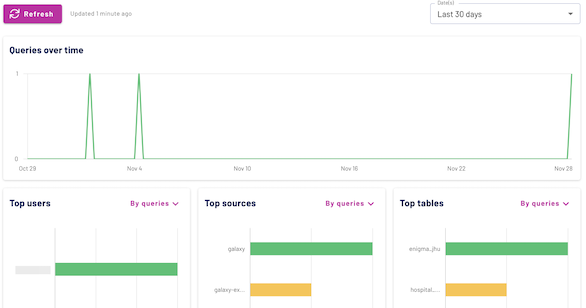Catalog level #
The first level of the catalog explorer is the catalog level, which contains a number of panes of information about the currently selected catalog.
Header section #
The header for catalog level panes shows the name of the currently selected catalog. Use the youtube_searched_for reindex icon as described in Catalog indexing.

Catalog metadata #
View and edit metadata associated with your catalog, such as a description, associated tags, a list of user contacts, and the catalog’s owning role.
In the header section of the catalog, click the expand_content icon to view and edit catalog metadata. Catalog metadata can only be edited by the catalog’s owner. Metadata is otherwise read-only.

- Description displays the description of the catalog, if any.
- Default type displays the default table format.
- Owner displays the owner of the catalog.
- Tags lists the tags associated with the catalog. Apply tags to the catalog to enable attribute-based access control policies.
- Contacts displays users who can provide information and support for the catalog. You can add any user with a role that owns the catalog directly, or indirectly.
Options menu #
Click the more_vert options menu to show the following options for catalog level panes:
- Query data opens a new query editor tab with the current catalog pre-selected in the location drop-down menus.
- Add to cluster lets you add this catalog to one or more clusters.
- Edit configuration opens the Edit catalog dialog to review or configure settings for the current catalog.
- Delete catalog deletes this catalog.
Schemas #
The Schemas pane displays a list of schemas found within the current catalog and any tags applied to each. In addition, a Status column shows the catalog indexing status for roles with the Manage account work privilege.
Refresh the list of schemas, or search through the list by using the Refresh button on the left, or the Search schemas field on the right, respectively.
Click the name of a schema to open the overview page for that schema.

Cluster participation #
The list of Clusters at the bottom of the Schemas list shows the clusters that contain the currently selected catalog. The list shows the following information about each cluster:
- Name: shows the name of the containing cluster.
- Status: displays the status.
- Cluster type: Standard, Fault Tolerant, or Accelerated.
- Owner: the role that owns the cluster.
- Actions: Clickable operations to run on this cluster, including:
- Query: Opens a new query editor tab with the current catalog and schema pre-selected in the location drop-down menus.
- more_vert
Options menu. Click to show:
- Partner connect: Directs you to partner connect where you can get the connection information required to connect to the cluster from various client tools.
- Add privileges: Opens an Add privileges dialog that allows you to add roles that have access to this cluster.
Add a catalog to one or more clusters by using the Add to cluster button, selecting the clusters from the menu, and clicking Add clusters. To add or remove regions from the clusters you are adding, click within the Select clusters menu to open a list of regions.
Schema discovery #
The Schema discovery pane only appears for object storage catalogs. Schema discovery lets you examine the metadata of the specified location to identify any tables or views that were added to this location since the last discovery.
If you are running schema discovery for the first time, click Run schema discovery to analyze a root object in an object storage location and return the structure of any discovered tables. If you have previously performed schema discovery for the chosen catalog, click Run discovery.
schema/table/<files/partition>. It cannot run on a file. For example,
the location s3://my-s3-bucket/my_csv_file.csv does not work.For further details, see Discover new object storage files.
Metrics #
The Metrics pane displays a visual analysis of important metrics about the current catalog, schema, table, or view:

Use the Dates menu above the chart to view data for different time intervals.
Charts display the following metrics:
- The Queries over time chart shows the absolute number of run, queued, and failed queries.
- The Top users chart shows the most active users by processed queries, by used CPU time, by data read, or by data written.
- The Top sources chart shows the most active client applications, such as the query editor, the Trino CLI, and others by processed queries, by used CPU time, by data read, or by data written.
- The Top tables chart shows the most active tables and views by processed queries, by data read, or by data written.
Quality #
View the results of data quality checks or create new data quality checks in the Quality tab at the table, schema, or catalog levels of the catalog explorer. See Data quality for further information.
Query history #
The Query history pane shows a list of queries that accessed the catalog. Look for queries that occurred within a pre-defined date range using the Dates drop-down list.
Query history is limited to your role’s history unless your current role is
accountadmin or your role has the View all query
history privilege.

Click Refresh to reload queries in the list.
The following columns are displayed:
- Status uses check for successfully completed queries, and close for failed queries.
- Query ID shows the unique identifier for each query; click the ID to open the Query details pane for the query.
- Cluster is the name of the cluster used to process the query.
- Query text displays the full or partial SQL text of the query.
- Email identifies the user who submitted the query.
- Role specifies the name of the role used by the user when submitting the query.
- Submitted date uses the browser timezone and shows the start date and time of the query processing.
- Elapsed time is the total duration for processing the query.
Audit log #
The Audit log pane displays an audit trail of administrative actions related to this catalog and its schemas, tables, views, materialized views, and columns. Your current role must have the View audit log privilege in order to see audit log entries from all users.
The following columns are shown:
- Operation: The configuration change that was performed. Possible values include update, delete, suspend, and others depending on the object.
- Object: The type of object, such as catalog or schema, for which the configuration was changed.
- Object name: The name of the specific object.
- What changed: A description of the changed attributes including values.
- User: The user who performed the change.
- Time of change: The date and time the change was performed.
Access control #
User accounts with permission to view privileges have access to the Access control pane. The Access control pane allows you to view privileges based on the currently active role.
The following columns are displayed:
- Role specifies the name of the role.
- Privileges shows the privileges for the role and ownership rights.
Use the Add privileges button to add or remove access to a privilege:
-
Select a role from the menu.
-
By default, new privileges allow access rights, but you can click the deny switch to create a deny privilege.
-
Select the privileges to grant to the current role, and click the Add privileges button to save the privilege grants.

To revoke an existing privilege:
- Click the X on a privilege tag.
- In the resulting dialog, click Yes, revoke privilege.

Is the information on this page helpful?
Yes
No
